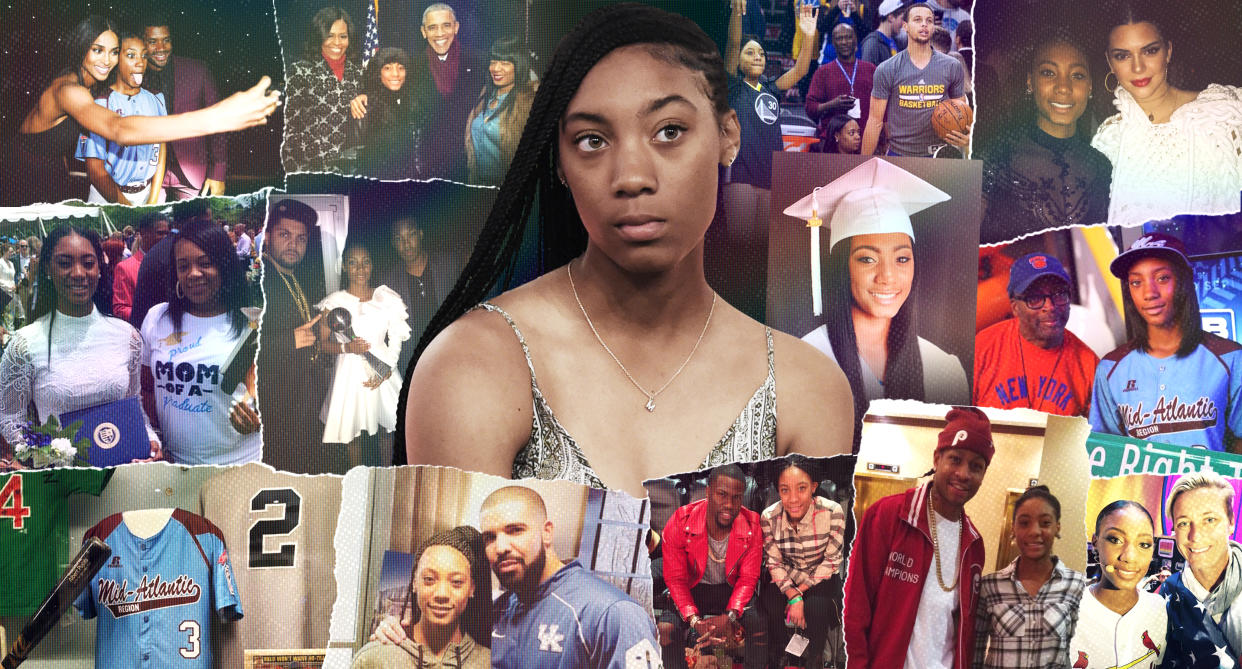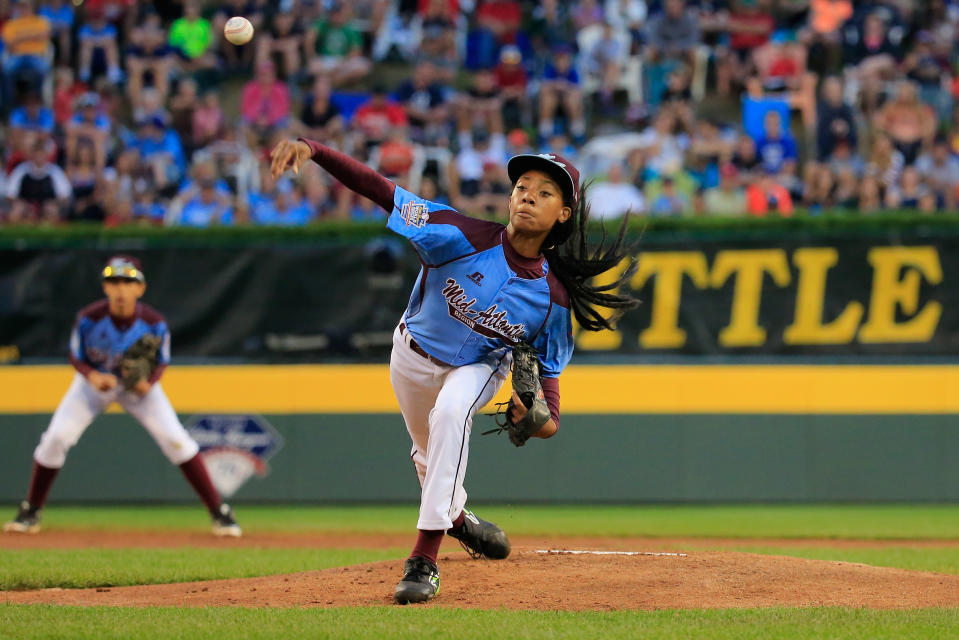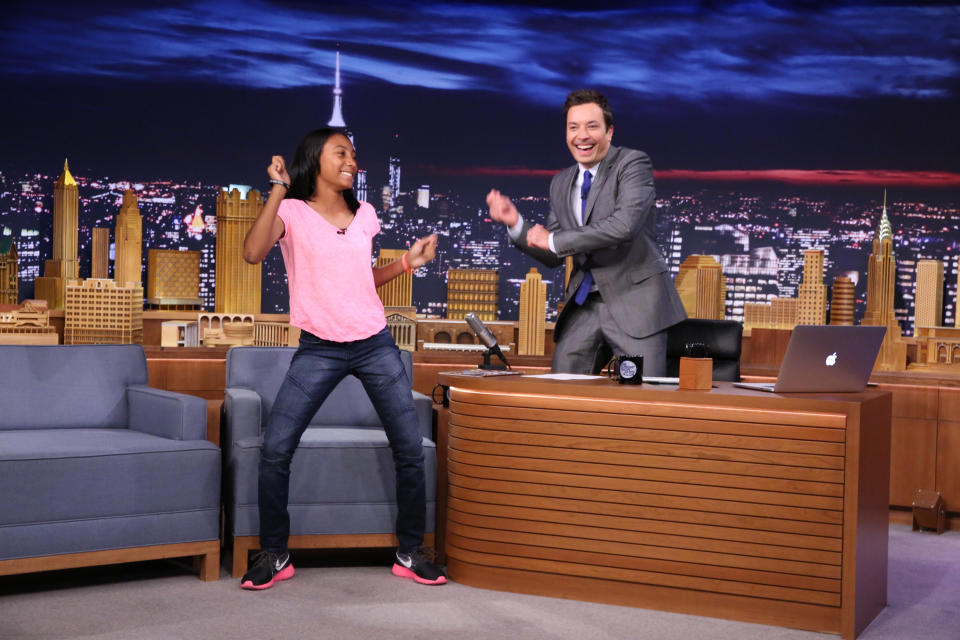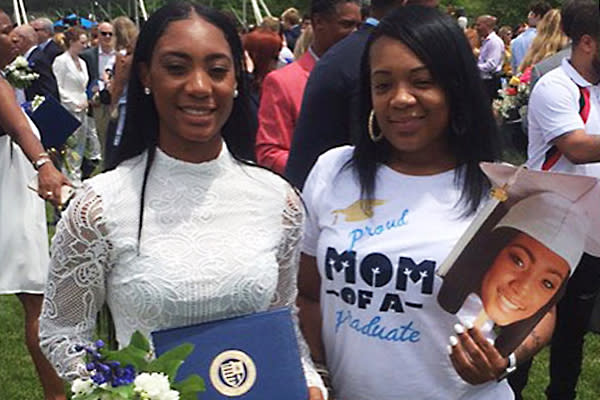Mo'ne Davis was a 13-year-old star. Where, and who, is she now?

PHILADELPHIA — Mo’ne Davis still remembers Day 1.
It was Aug. 14, 2014, the start of five years few teenagers have ever experienced. Coaches had warned her: “It’s gonna get crazy.” Mo’ne thought she knew what they meant. Until, that is, she tried to spend a quiet afternoon with two teammates in the “rec room” at the Little League World Series. “Nobody’s in there,” Mo’ne begins. “We’re just watching TV. Ya know, just chillin’ out. And then three other players come up. … They’re like, ‘Mo, your cousins from North Philly said they wanted to meet you.’ ”
Which might have sounded like fun, until Mo’ne thought: “ … I don’t have any cousins from North Philly.”
She was perplexed and wary, but intrigued. “So we walk down,” she continues. “And once one person sees you, then everybody sees you.” Suddenly, they were trapped. Barely able to move. Surrounded by ravenous autograph seekers. And the three teammates who baited her into the frenzy? “Nowhere to be found.”
The experience doubled as the realization. It earned her a scolding from a coach and security. It was the end of her Williamsport freedom. The start of golf cart rides and escorts. And the start, in earnest, of unprecedented fame.
The following day, Mo’ne became the first girl to throw a Little League World Series shutout. Her 70-mile-per-hour fastball propelled her to the cover of Sports Illustrated, and later Time magazine. To late-night TV sets and award ceremonies. To Drake concerts and the White House.
Five years later, the storm has largely subsided. But there are still remnants. Reminders. Like the one an elderly couple is about to offer up on a sunny morning in late May. They sit patiently outside a South Philly sports bar. Interstate traffic buzzes by in the distance. When Davis strides past them into the restaurant for lunch, their brains begin to churn, connecting 2014 to today. Their double-takes are noticeable – and, according to Davis, still not uncommon. Perhaps her athletic pants and Anderson Monarchs T-shirt are the giveaway. Or, perhaps, the silver “M” dangling from a necklace and resting on her chest. Or the features that have persisted through puberty – the sharp eyes, the steely face, the leisurely smile that can light up a room.
For Mo’ne, on this late-spring day, graduation is a week away. Up next, two months later, will be college. Davis, in mid-August, will head to Hampton University. But not to pursue a barrier-smashing baseball career like some predicted – she says she never truly considered that a possibility. Nor will she chase the hoop dreams she once harbored. Her oft-professed love for basketball ebbed last summer, and an ankle injury accelerated her detour down a different path.
Rather, she’s headed to the historically black university in Virginia to play softball. And to learn. Just like thousands of others.
Her present, in so many ways, is typical. Flanked by her mom, Lakeisha, and stepdad, Mark, over almost two hours at a window-adjacent booth, she weaves serious conversations with lighthearted ones. She picks away at crabcakes. She doesn’t touch a lonely piece of lettuce on her plate. When Lakeisha offers up photos of her bedroom, she playfully resists – “No no no no no, don’t do that” – then relents. “It’s messed up. It’s bad,” she says with a slight cringe as Lakeisha’s phone reveals shoes and clothes strewn across the floor.
She is an untidy 18-year-old with overflowing bins of “stuff,” with questionable Rita’s Water Ice preferences, with what her mom jokingly calls “the mind of a 2-year-old,” and with an entire adult life ahead of her.
Let her get comfortable, though, and the memories begin to flow. Let the memories begin to flow, and you’ll realize the obvious: Davis is uniquely atypical. Remarkably mature, yet still a kid at heart. The one who had shoes and portraits sent by strangers to her house and campus; who had to change her phone number to evade “random calls”; but who introduces herself with a soft handshake and a “Hi, I’m Mo’ne,” as if the vast majority of people who meet her don’t already know.
The past five years of her life have been full of fascinating contrasts. She is one of the few female athletes who can bring up Zion Williamson and NCAA amateurism rules … and have the discussion, in a tangential way, pertain to her. She speaks of advocating for gender equality in sports “once I have the platform” ... though many would assume that platform will never be as large as it was when she was far too young to articulate the educated, nuanced opinions she can today.
Her instant fame took her coast to coast. To fit both Steph Curry and LeBron James onto a Mount Rushmore of celebrities she’s met, she has to count Barack and Michelle Obama as a single item. And there’s no room for Rihanna or Meek Mill or Nikki Minaj. Drake will have to settle for “honorable mention.” So will countless others, some of whom asked for her autograph.
And yet, Davis says: “I hate when people ask me how it feels to be famous. Like, I’m not famous.”
Rather, she caught glimpses. Got tastes. And for the most part, savored them. But for the people who pose that question about fame, she has a succinct and insightful message: “You don’t understand.”

Just a girl from South Philly
Before Mo’ne Davis was Mo’ne Davis, she was just another South Philly kid who loved to play. She was “a crybaby,” according to her mother, and admittedly shy. “Never wanted to leave my house,” Mo’ne says.
Except she would, almost every summer morning, on a bicycle. She’d meet a flock of neighborhood kids and ride to the local YMCA to hoop. Hours later, they’d hop back on their bikes, pedal to the nearest park, and swap basketball for baseball. The following morning, they’d do it all again.
At 7, Mo’ne latched on with the Monarchs, an inner-city, multi-sport rec team. She transferred to a private school in the city’s quasi-suburban northwest. Years later, there was Taney Little League, and states, then regionals up in Connecticut. That’s where the retelling of the whirlwind begins. “Nobody thought that we would actually go all the way,” Mo’ne remembers. Mark backs her up: “They was like, ‘Oh, [you] only gonna be there three days.’ ”
Instead, 10 days later, after Mo’ne had hurled a three-hit shutout in the regional final, they were bussing down to Williamsport as burgeoning celebs, tired and carsick. “Somehow,” Mo’ne recalls, “the Ellen [Degeneres Show] producers got the catcher’s phone number, and they were calling him, and asking him questions. And he was the most carsick out of everybody. He couldn’t talk. So we gave [the phone] to our coach, and our coach was carsick, too. So we had to pull over, and everybody just got off the bus. And the coach was like, ‘You know what, don’t answer your phones, unless it’s your parents. We are not doing this.’ ”
Of course, they had no idea what awaited them – especially after Mo’ne two-hit Tennessee in their Little League World Series opener.
Five years later, the stories of those two weeks remain astounding. There’s one of a woman who supposedly locked her dog in her garage, 200-plus miles away, so she could trek to Williamsport and get Mo’ne to sign a poster. Then there was the SI cover, which stemmed from what Mo’ne remembers as a five-minute interview that interrupted a ping-pong game. “I just thought it was a regular article,” she says. Her parents kept the secret for two days. “Nobody told me I’d be on the cover until one of the chaperones came in with a stack of them for each person on the team. [The chaperone] was like, ‘Can you sign these?’ And I was like… Whaaat?’ ”
The entire American sporting world latched on. Kevin Durant, Mike Trout, Michelle Obama, Lil Wayne and Russell Wilson were among the many who tweeted about her. Big-name reporters and TV bookers bombarded her phone.
Only once was she able to escape it all and stroll in peace. With a UConn hoodie and glasses concealing her identity. One lap around the complex. Then another.
“And nobody said anything,” she reminisces. “It was the best thing ever.”

The most popular 13-year-old in America
What Mo’ne didn’t like, and still doesn’t, are the paparazzi. And the constant, distracting clamors for her attention. Throughout the five years, she got them most often at baseball tournaments. Over the final four-plus months of 2014, she got them everywhere.
What she did like were the travels; the celebrity encounters; those tastes of glamor. Her parents never worried about them becoming overwhelming. “Uh uh,” Mark says, shaking his head. “Run with it,” Lakeisha says of her daughter’s newfound fame.
Lakeisha and others took on roles as her managers, handling requests and invites of all kinds. Before long, Mo’ne had appeared on the Today Show, cruised to a Los Angeles Dodgers game with Queen Latifah, and threw pitches to Jimmy Fallon. She’d written a memoir and starred in a Spike Lee short. She’d soaked up NBA All-Star weekend after spinning Kevin Hart out of his shoes. Her verified Instagram page, which is now up to 250,000 followers, boasts photos with a who’s who of NBAers and pop culture icons.
Along the way, she met civil rights activists and famous rappers; Phillies favorites and Allen Iverson; Magic Johnson, Kobe Bryant and Tom Hanks. She rode in limos. Did photoshoots. Received keys to cities she’d never lived in, and Instagram shoutouts from Drake. Shortly after that photo hit friends’ timelines, she FaceTimed with one in a photography class – which Mo’ne would have been in if not for a book-signing event out west. The teacher, one of her favorites, hopped on the phone. “Oh, so while we’re in school,” the teacher ribbed, “you’re just over there hanging with Drake.’”
Mo’ne threw out World Series first pitches. Attended MLS and WNBA games. Got a hug from Maya Moore as reporters stuffed microphones in her face. She participated in high-powered panels. Was drafted by the Harlem Globetrotters. Got her jersey enshrined in the Baseball Hall of Fame.
She won AP Female Athlete of the Year, a BET award and an ESPY. That night, 11 months after she rose to prominence, she froze up in the presence of Alex Morgan. “That’s the first time I ever seen her freeze up,” Lakeisha says. “I was like, Helloooo.”
Hours later, back at their hotel, an ESPN personality invited them to go party with LeBron. Alas, “it was like 4 in the morning,” Mo’ne says. A tad past a young teenager’s bedtime.
To some extent, academics and everyday life sheltered her from the insanity. But “in eighth grade,” she notes, “I was barely in school.” When she was, kids she’d never spoken with began to say hi in the halls. Randos got her phone number, and her address, and her uncle’s address. A few showed up at school. One couple brought a professional-looking drawing of her on the mound, eyes narrowed, Little League uniform and all. After the head of middle school screened it to ensure the package contained nothing malicious, she passed it along to Mo’ne, who hung it in her bedroom.
She was, at the time, arguably the most popular 13-year-old in America. Which raises an interesting question: What, exactly, is 13-year-old fame worth?
Not for profit
About 45 minutes into lunch, conversation turns to the NCAA. Mo’ne, perhaps primed by one of a few dozen TVs lining the restaurant’s walls, mentions a man 11 months her senior whom those TVs won’t stop showing.
“What they just made off of Zion? C’mon now,” she says of the former Duke star and the multiple non-profit institutions that profited from his greatness. “They just made millions and millions of dollars off of that kid. And he didn’t get one single penny of it.”
“And,” she continues, “they wonder why people are skipping college to go overseas.”
The discussion flows into chatter about one of those college-skippers, R.J. Hampton; and about the insufficiency of a scholarship. Mark ridicules schools who pay coaches seven figures, then turn around and cry poverty when asked about paying athletes. Lakeisha has a proposal: “If you don’t want to give a child money, put it in a trust fund.”
Zion, of course, will eventually make his fortune. His year-plus of endorsement dollars lost will be overshadowed by the tens of millions that roll in. But what about precocious stars whose talent and maturity make them wildly marketable as teens, who might not wield the same influence years later when they duck out from under the NCAA’s inhibitive umbrella? What about, say, Mo’ne Davis?
Her meteoric ascent stimulated a flood of endorsement offers from companies of all kinds. The NCAA’s rules governing amateurism and eligibility, however, complicated them. Mo’ne aspired to play college basketball. So whenever a commercial opportunity arose, Lakeisha had to run it by an assigned NCAA rep to ensure Mo’ne’s eligibility would remain unaffected. Among the ventures the NCAA signed off on was the Spike Lee film, which doubled as a Chevrolet advertisement, for which Mo’ne was compensated. There were also shoe and watch lines, for which she was not. Both, instead, benefited charitable causes.
Mo’ne doesn’t recall the NCAA specifically impeding any opportunities she wanted to pursue. But the longstanding rules likely preempted many. Her ability to capitalize monetarily on her near-overnight fame was surely impacted.
In fact, Mo’ne speaks openly about wanting to sign with Nike someday. Doing so five years ago would have ruffled the NCAA’s hypersensitive feathers. It – and/or similar endorsements – might have been financially beneficial in the long run. But it would have extinguished her athletic ambitions.

Life moves on for Mo’ne
For years, Mo’ne dreamed of playing a sport professionally. That sport was basketball. She watched it “alll the time,” and played it even more. She was a savvy, fearless point guard. She would’ve loved to have played for Geno Auriemma at UConn.
But with her high school team struggling – “the past two years, I’ve kinda been trying to do everything myself” – and with an ankle injury hampering her, enjoyment waned. “I just stopped liking it,” Mo’ne says of basketball. “I stopped having fun with it.”
She was not an elite college prospect, but had leapt into the AAU world. “If I really wanted to,” she says now, “I coulda actually gone D-I.” Last year, however, she decided pleasure took precedent. “I was scared to tell people at first,” she explains. “I was like, I’ve spent two-and-a-half summers playing basketball and traveling all over, and my parents spending all this money, and my coach sending out all these emails for me.”
A parent tries to cut her off, but with a “no, wait, wait, no you wait,” she continues: “I told two of my friends first. And then I texted my brother that night, too. And then I told Squirt.”
Squirt is her nickname for her stepdad, Mark. “She texted me, just, ‘Squirt,’ ” he explains. “And I’m like, ‘OK, what does she want?’ So I said, ‘Yes...’ She said, ‘I don’t think I want to play basketball anymore.’ So I picked up the phone and called her.” And after Mo’ne gave her explanation, “I said, ‘I don’t care if you play or not! It’s not up to me, make your own decision!’ ... It was just the way she said it. I don’t think she wanted to tell me that.”
“I didn’t even tell my coach,” Mo’ne adds. “Squirt had to do it for me.”
Mo’ne turned to the other two sports she played throughout high school, soccer and softball, in two different ways. The former – specifically, the NWSL and U.S. women’s national team – has become her favorite to watch. She told family members she was busy on World Cup gamedays. Sat on the bench during a baseball game to watch one USWNT match on her phone. Cried in a van on the way back from Cooperstown when her favorite player, Christen Press, scored in the semifinal against England. “She wants the whole house to be quiet,” Lakeisha says of her daughter whenever the U.S. women are on.
But in May, with the World Cup opener more than a week away, Mo’ne glances up at a TV and perks up. “That’s another sport that’s good to watch,” she says. “College softball. Oh, my, goodness. It’s crazy.”
Pretty soon, it’ll be her sport. She’s a smooth shortstop and a battler at the plate.
Before she can go on, though, Lakeisha chimes in. “Do they go somewhere after?” she asks of the softball stars that have flashed across ESPN. “There’s no league.”
Mo’ne corrects her: “No, there is a league.” National Pro Fastpitch, to be specific. “There’s six teams,” Mo’ne explains. “So the roster is stacked.”
Lakeisha presses: “So they get paid?”
“Yeah, but not a lot,” Mo’ne says. “It’s just like any other women’s sport. You never catch women getting paid just as much [as men].”
Lakeisha responds: “Women need to stand up. Get the same rights.”
Mo’ne assures her: “Yeah, that’s what they’re doing. And it’s still not working.”
As a female athlete and USWNT diehard, the multi-sport battle for better treatment is right up her alley. One of the reasons she fell in love with the soccer team, she says, is “what they’re fighting for.” She wrote a high school paper on their 2016 gender discrimination complaint, which morphed into a lawsuit earlier this year.
As she explains the paper, though, her parents strike up a side conversation. “Watchu talkin about?” Mo’ne inquires.
Says Mark, with a somewhat mischievous smile on his face: “My question was, ‘So you wouldn’t stand up for women’s sports?’ ” Lakeisha, apparently, doesn’t think Mo’ne would.
“Yes I would,” Mo’ne shoots back. “You trippin’.”
“Well you should,” Lakeisha replies.
To which Mo’ne responds: “If I feel like it’s right, if I feel like that’s what needs to happen, I’ll do it.”
And Lakeisha: “It do need to happen. So stand up.”
And Mo’ne: “How am I supposed to stand up? I can’t get paid.”
They eventually meet in the middle, agreeing and acknowledging that while Mo’ne can’t yet act to effect change, she can speak. And she has been, ever since age 13. She was a role model before she had a driver’s license. She was asked, on camera, about topics adults struggle to comprehend. She handled them with aplomb.
As she says now, though: “I was just so young, and all I was saying was, girls should be able to do the same thing guys are doing. But now, it’s to a totally different level. With age comes different responsibilities.”
For her, unlike the vast majority of well-known athletes, with age has come fewer eyeballs. Fewer ears. A gradual return to normalcy gradually turned them elsewhere.
Some of her audience, however, will stick around – especially if her desire to do “something fun” in broadcast media comes to fruition. So has she thought much about using that audience to make a difference?
“I definitely want to,” she says, taking the question in terms of gender equality. “I haven’t really thought too much about it because I feel like the women that are speaking up are doing as best as they can. But once I have the platform to be able to do it, I definitely will until it’s right. Because at the moment, how they’re being treated is not right at all.”
Just being Mo’ne
When Mo’ne ventured down to Hampton last fall for a softball camp that functioned as a recruiting visit, she found what she calls a “family atmosphere.” It’s a main reason she committed months later. Another was the strength of the school’s journalism and communications program.
But one aspect of the visit in particular stuck with her. One of the assistant coaches had a teenage daughter. The daughter’s travel team was there for camp as well. And the girls, naturally, wanted pictures.
The assistant coach, however, “was being real,” Mo’ne recalls. “He was like, ‘I know everything that you went through. … I’m not gonna allow them to take a picture. I want you to feel just as any other camper here [would]. I want you to feel like you’re safe.’ ”
“I like that,” she says of the gesture and the environment it was designed to create. An environment where she doesn’t have to be Mo’ne Davis. Just Mo’ne Davis. Or Mo’ne. Perhaps even Mo.
A high school teacher recently asked her whether she’d need a special living arrangement at Hampton: “Will people constantly come to your dorm?” Davis doesn’t think they will. She’s more preoccupied with standard freshman things, such as “all my stuff.” Shoes, memorabilia, perhaps the odd magazine with her picture on it. “I need a basement. I need a house,” she says with a laugh. “I have too much stuff.”
It’s telling, actually, that some of her favorite memories from five years ago aren’t the strikeouts; aren’t the ESPN appearances; aren’t the attention. When with teammates, who still double as some of her best friends, she doesn’t rehash the stories as often as you’d think. The “one that sticks out,” she says, was an off day in the rec room. “They gave us these little squishy baseballs. And one of the kids just turned out the lights. We split the room in half, and it ended up being the world vs. U.S., and we just had a dodgeball game. And somebody knocked the exit sign down. It was crazy.”
When weighty topics arise, like equality or the monetization of fame, the tone of her voice changes. It’s as if she can flip a switch and become an adult. The past five years have forced her to. But not permanently. She still orders fruit punch gatorade. Still enjoys soft-serve ice cream with sprinkles, or Swedish Fish-flavored water ice. Still calls to ask her mom to order the occasional Nike shirt. And asks for it not in women’s sizes, but in kids’.
The past five years, instead, have given her perspective. She likes “going hotel to hotel.” But of people who worship fame, she says: “They don’t know what accompanies it. … You don’t have no alone time. No time to yourself.”
“That’s why I don’t like asking for pictures,” she continues. “If I see, especially an athlete, I won’t ask for a picture. Because I know how it is. ... And my mom’s like, ‘Just go ask, they’ll take a picture!’ I don’t like doing that. I don’t know how their day has been.
“But normally, they’ll be like, ‘Oh, for sure, definitely.’” Oh, and sometimes, “they’ll be like... ‘Can I take one too?’ ”
She is, after all, Mo’ne Davis.
But while the 2014 Little League World Series undoubtedly changed the last five years of her life, and almost forced her to become more outgoing, “I think I’m still the same person,” she says. Still that South Philly youngster. The one who’d roam until sundown. Those long summer days, she says, she’ll “always remember” and “never forget.”
“Because nowadays, nobody rides their bike around early in the morning or late at night.” A hint of wistfulness is seeping into her voice. “That was one of my favorite things. And I always talk about how I want to keep doing it. But I never find time.”
– – – – – – –
Nikki Baim contributed reporting.
Henry Bushnell is a features writer for Yahoo Sports. Have a tip? Question? Comment? Email him at henrydbushnell@gmail.com, or follow him on Twitter @HenryBushnell, and on Facebook.

 Yahoo Lifestyle
Yahoo Lifestyle 

